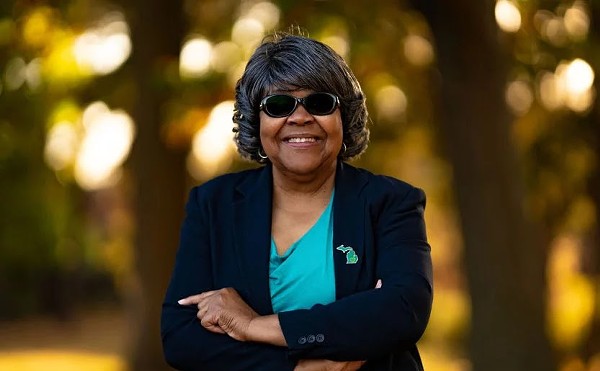Scavengers have stripped marble from its walls. Chandeliers, lavatory sinks and a large bronze clock that once loomed above the ticket counter are gone. Even some of the copper wiring has been looted from the Michigan Central Station, which has haunted Detroit’s southwest side since Amtrak pulled out in 1988.
Despite its broken windows and dingy facade, community advocates, preservationists and the like have not given up on the hulking landmark. They soon may have reason to celebrate.
The City of Detroit is considering the old train station, as well as the former site of Joe Muer’s restaurant on Gratiot, for a new police headquarters, according to Henry Hagood, planning and development director.
The city asked developers to submit proposals for a new 250,000-square-foot police headquarters, which should include administrative offices, conference rooms, a shooting range and other amenities. The city did not ask for a police lockup.
The current headquarters, which was built in 1923, is rife with problems. Last year, a broken pipe flooded the basement, temporarily knocking out the city’s 911 call center.
The city received several proposals, including one from CenTra Inc., which owns the train station.
If the city chooses CenTra, business mogul Manuel J. “Matty” Moroun may be deemed a hero. Moroun runs CenTra, which owns the Ambassador Bridge and trucking companies. He hasn’t always been popular on the southwest side, where some residents have complained that his operations hamper the neighborhood.
The train station’s neighbors are ecstatic at the prospect that the police may take up residence there.
“We have been so gratified by the community support that this has received,” says Mickey Blashfield, CenTra’s government relations director.
Eleven community groups that make up the Gateway Collaborative, which promotes development in Corktown and Southwest Detroit, unanimously support the plan.
“Currently, the train station casts a shadow over Corktown and Mexicantown,” says Kelli B. Kavanaugh, administrator of the Corktown Citizens District Council, a Gateway Collaborative member. “Having a building that contributes to the growth of the neighborhoods will only serve as a bridge rather than a barrier.”
Kavanaugh, author of Detroit’s Michigan Central Station, a photo history of the train depot, predicts that moving the police headquarters there will spur development in the area.
The only anxiety residents had about the proposal was parking, she says.
“We don’t want there to be a huge parking lot in front of the train station,” says Kavanaugh.
The city did not say how many people would move into the building, but specifications call for 800 parking spaces. Blashfield says CenTra’s proposal exceeds this requirement. A warehouse adjacent the train depot would be converted to a parking structure, with another one built beside it, he says. If necessary, a third one could be built on the surface lot north of the station, says Blashfield.
Kathy Wendler, executive director of the Southwest Detroit Business Association, also a Gateway Collaborative member, says redeveloping the train station is not only good for the neighborhood, but the city.
“I’d like to say that it is a wonderful local, neighborhood thing, but it is way beyond that,” says Wendler. “I think it will resonate across the region and it is an opportunity for the city to get national press coverage.”
Ken Cockrel, president pro tem of the Detroit City Council, is most interested in saving the city money by consolidating police administrators into one building. Ken Cockrel, who lives about a mile north of the train station, says the department’s top brass are currently housed in several buildings.
“We are paying rent at those locations, which adds up,” he says. “From a cost-efficiency standpoint, it makes sense to pay one bill for rent and consolidate other payments like utilities.”
“I think adaptive reuse is a wonderful thing,” says Councilwoman Sheila Cockrel, but she wants more details. The council will not review plans for the police headquarters until the mayor selects a developer.
According to Blashfield, the city wants a “turnkey” operation. CenTra would pay for the renovation and lease the space for police headquarters.
Sheila Cockrel says she wants to be sure that the city doesn’t run into the same problem it now has with 36th District Court. The city leases the building and pays for repairs, she says.
She is not the only one curious about the lease agreement and other details. Folks regularly chat about Michigan Central Station at detroityes.com, a Web site devoted to all things Detroit.
Steve Haag, 32, a passionate preservationist, posts on the site, under the pseudonym “Hamtramck Steve.”
“They [old buildings] are one of the things that make Detroit unique,” says Haag, who chairs Friends of the Book-Cadillac Hotel, which promoted efforts to renovate that building.
Last month, Mayor Kwame Kilpatrick said that the hotel would be saved, and said he would soon make a similar announcement about the train station, which was completed in 1913 with a 19th century Beaux Arts design.
Haag contends that it’s cheaper to renovate old buildings that are structurally sound than to build new ones. That’s why he thinks moving police headquarters into the train station makes sense.
In a July 17 posting, Haag said he heard from a confidential source that, “The owner will pay the full cost of the renovation to create a new police [headquarters] in exchange for a, I think, 30-year lease. The lease is under $20 a square foot.”
Haag would not identify his source.
Blashfield would not comment on Haag’s posting.
“We are not going to get into any details until they are final,” he says.
But if what Haag says is true, $20 a square foot is reasonable. Downtown office space rents for $16 to $30 a square foot, according to Andy Farbman, a prominent local developer.
“It depends on the class of building and its amenities,” says Farbman, who proposed housing the new police headquarters in the former Detroit Free Press building. He says the city is no longer considering that plan.
“I haven’t heard from the city in about three months,” says Farbman.
The city originally was scheduled to choose a final developer May 30, but extended the deadline. Around that same time, the U.S. Justice Department announced that it would monitor the department after a two-year investigation of fatal police shootings, deaths in the city lockups and other matters. Some speculate that the city may not have wanted to appear that it was rewarding the department with a new headquarters.
The mayor and Police Chief Jerry Oliver will make the final decision, says Blashfield. Oliver, who reportedly said early on that he wanted a new facility built, declined to comment.
“The bottom line is that it could easily accommodate the Police Department and then some,” says Blashfield.
The 230-foot high building has 550,000 square feet. The police would be the anchor tenant, but there would be room for others, says Blashfield.
“It is a steel-and-concrete formation designed by railroad engineers and it was stably built from day one and remains that way,” says Blashfield.
Whatever the city decides, tearing the train station down is not an option, says Blashfield.
“We have not considered it,” he says. “Besides, I’m not sure there is enough dynamite in the region to do it.”
Read the other Corktown features in this issue:
The neighborhood that wouldn't die
By Sarah Klein
Despite abandoned and decaying landmarks, Corktown pulses with life.
A hole in the heart
By Curt Guyette
Corktown’s lost field of dreams.





